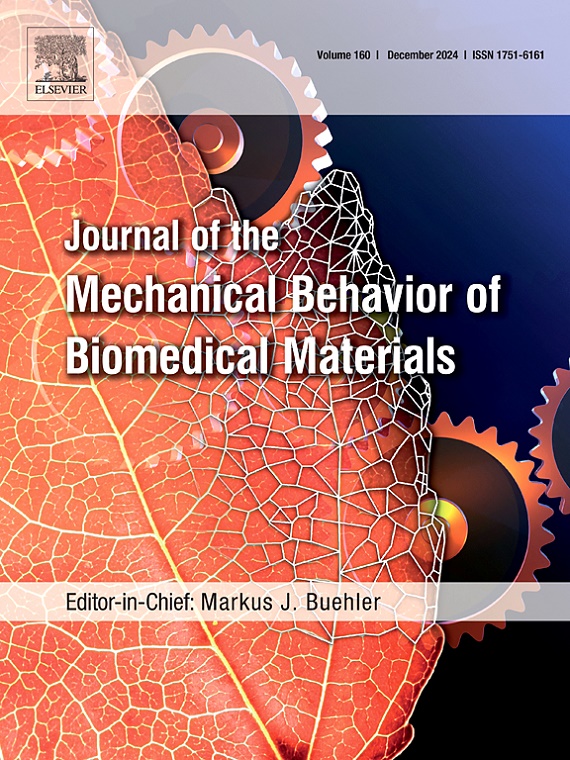Skeletal impacts of dual in vivo compressive axial tibial and ulnar loading in mice
IF 3.3
2区 医学
Q2 ENGINEERING, BIOMEDICAL
Journal of the Mechanical Behavior of Biomedical Materials
Pub Date : 2025-02-12
DOI:10.1016/j.jmbbm.2025.106950
引用次数: 0
Abstract
The use of compressive axial tibial loading for evaluation of bone adaptation and mechanotransduction has become a common technique in recent years. Despite its popularity, it only produces a single experimental limb per animal which can escalate sample sizes depending on study endpoints. We hypothesized the combination of compressive axial tibial and ulnar loading in a single animal would induce bone formation in loaded limbs, providing two experimental limbs per animal thereby reducing the animals required per study by half. Male and female C57BL/6J mice were purchased at 9 and 19 weeks (wks). Based on sex and age they were divided into 4 groups of N = 17. From each group, N = 5 were sacrificed at 10 and 20 wks for strain gauge calibration. At 11 wks and 21 wks, the left ulnae and right tibiae of the remaining animals (N = 12/group) were loaded 3 days/week for 4 weeks. Tibiae of all groups experienced significant increases in architectural properties due to loading in both trabecular and cortical compartments while there were no significant improvements in the ulna. Female tibiae showed improvements in mechanical properties, but these were not observed in the male tibiae where detrimental impacts were observed. In the ulna, females showed limited mechanical changes due to loading. Contrastingly, loading in males at 11 wks led to decreased mechanical properties while at 21 wks no impacts were observed. Overall, reported beneficial impacts of loading in tibiae were observed in architectural properties but were not maintained in the males’ mechanical properties. Impacts of ulnar loading on architectural and whole bone mechanical properties that have been reported elsewhere were not observed in any groups. These data suggest when architectural and mechanical properties are end points, combined loading is not optimal for reducing the number of animals required per study.

小鼠体内轴向胫骨和尺骨双重压缩载荷对骨骼的影响
近年来,使用胫骨轴向压缩载荷评估骨适应和机械转导已成为一种常见的技术。尽管它很受欢迎,但每只动物只能产生一个实验肢体,这可能会根据研究终点增加样本量。我们假设单个动物的胫骨轴向和尺侧压缩载荷的组合会诱导受载荷肢体的骨形成,每只动物提供两个实验肢体,从而将每次研究所需的动物数量减少一半。分别于第9周和第19周购买雄性和雌性C57BL/6J小鼠。根据性别和年龄分为4组,每组17人。每组分别于10周和20周处死N = 5,用于应变片校准。在11周和21周,其余动物(N = 12/组)的左尺骨和右胫骨每周加载3天,连续4周。由于骨小梁和皮质间室的负荷,所有组的胫骨的建筑特性都有显著的增加,而尺骨没有显著的改善。女性胫骨的机械性能有所改善,但在男性胫骨中没有观察到这些不利影响。在尺骨上,女性由于负荷表现出有限的机械变化。相反,在11周时,雄性小鼠的负荷导致机械性能下降,而在21周时,没有观察到任何影响。总的来说,已报道的胫骨载荷的有益影响在建筑性能上被观察到,但在男性的机械性能上没有得到维持。其他地方报道的尺骨负荷对建筑和全骨力学性能的影响在任何组中都没有观察到。这些数据表明,当建筑和机械性能作为终点时,联合加载对于减少每次研究所需的动物数量并不是最佳的。
本文章由计算机程序翻译,如有差异,请以英文原文为准。
求助全文
约1分钟内获得全文
求助全文
来源期刊

Journal of the Mechanical Behavior of Biomedical Materials
工程技术-材料科学:生物材料
CiteScore
7.20
自引率
7.70%
发文量
505
审稿时长
46 days
期刊介绍:
The Journal of the Mechanical Behavior of Biomedical Materials is concerned with the mechanical deformation, damage and failure under applied forces, of biological material (at the tissue, cellular and molecular levels) and of biomaterials, i.e. those materials which are designed to mimic or replace biological materials.
The primary focus of the journal is the synthesis of materials science, biology, and medical and dental science. Reports of fundamental scientific investigations are welcome, as are articles concerned with the practical application of materials in medical devices. Both experimental and theoretical work is of interest; theoretical papers will normally include comparison of predictions with experimental data, though we recognize that this may not always be appropriate. The journal also publishes technical notes concerned with emerging experimental or theoretical techniques, letters to the editor and, by invitation, review articles and papers describing existing techniques for the benefit of an interdisciplinary readership.
 求助内容:
求助内容: 应助结果提醒方式:
应助结果提醒方式:


